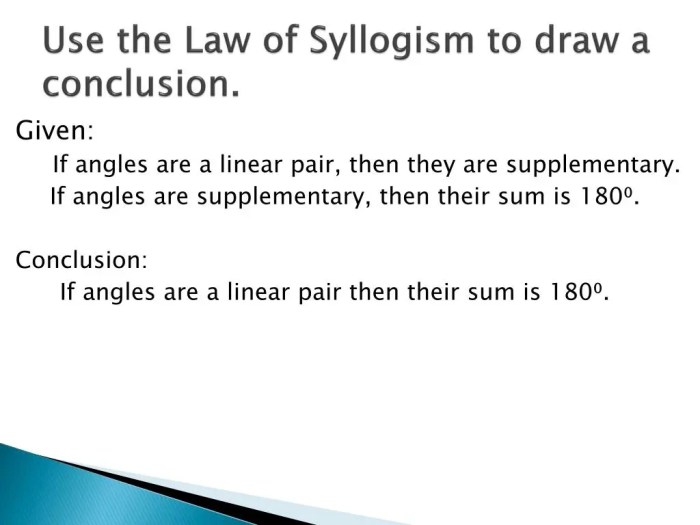The Law of Detachment and Syllogism Worksheet delves into the realm of deductive reasoning, providing a comprehensive guide to these fundamental principles of logic. This worksheet empowers learners to sharpen their critical thinking skills, enabling them to analyze arguments and draw sound conclusions.
The worksheet encompasses a thorough explanation of the Law of Detachment, defining it as a logical rule that allows one to infer a specific conclusion from a general premise. It also explores the concept of syllogism, a deductive argument consisting of two premises and a conclusion.
By understanding these principles, individuals can enhance their ability to evaluate arguments and make informed decisions.
Law of Detachment and Syllogism: Law Of Detachment And Syllogism Worksheet

In logic, the law of detachment and syllogism are two fundamental principles that allow us to derive new conclusions from given premises.
Law of Detachment
The law of detachment states that if a conditional statement is true, and the antecedent of the statement is also true, then the consequent of the statement must also be true.
For example, consider the following conditional statement: “If it is raining, then the ground is wet.” If we know that it is raining, then we can use the law of detachment to conclude that the ground is wet.
The law of detachment is an important principle of logic because it allows us to derive new conclusions from given premises. This principle is used in a variety of applications, including mathematics, computer science, and philosophy.
Syllogism
A syllogism is a logical argument that consists of three parts: a major premise, a minor premise, and a conclusion.
The major premise is a general statement about a category of things. The minor premise is a specific statement about a member of that category. The conclusion is a statement that follows logically from the major and minor premises.
For example, consider the following syllogism:
- All men are mortal. (Major premise)
- Socrates is a man. (Minor premise)
- Therefore, Socrates is mortal. (Conclusion)
This syllogism is valid because the conclusion follows logically from the major and minor premises. The law of detachment can be used to prove the validity of a syllogism.
Worksheet
A worksheet on the law of detachment and syllogism could include the following practice problems:
- True/False questions:
- The law of detachment states that if the antecedent of a conditional statement is true, then the consequent of the statement must also be true.
- A syllogism is a logical argument that consists of two parts: a major premise and a minor premise.
- Multiple-choice questions:
- Which of the following is an example of the law of detachment?
- If it is raining, then the ground is wet. It is raining. Therefore, the ground is wet.
- All men are mortal. Socrates is a man. Therefore, Socrates is mortal.
- Which of the following is a valid syllogism?
- All dogs are mammals. All mammals are animals. Therefore, all dogs are animals.
- All birds can fly. Penguins are birds. Therefore, penguins can fly.
- Which of the following is an example of the law of detachment?
- Short answer questions:
- Explain the law of detachment in your own words.
- Provide an example of a valid syllogism.
Answer keys for the worksheet could be provided at the end of the worksheet.
Applications, Law of detachment and syllogism worksheet
The law of detachment and syllogism have a wide range of applications in real-world situations.
For example, the law of detachment can be used to prove the guilt of a defendant in a criminal trial. If the prosecution can prove that the defendant committed a crime, and that the crime was committed with a specific weapon, then the jury can use the law of detachment to conclude that the defendant must have used that weapon to commit the crime.
Syllogisms can be used to make decisions in a variety of situations. For example, a doctor might use a syllogism to decide whether or not to prescribe a particular medication to a patient. The doctor might reason that all patients with a certain condition should be prescribed a particular medication, and that the patient in question has that condition.
Therefore, the doctor can conclude that the patient should be prescribed the medication.
Understanding the law of detachment and syllogism is essential for critical thinking. These principles allow us to evaluate arguments and make sound decisions.
Questions and Answers
What is the Law of Detachment?
The Law of Detachment is a rule of inference that states that if a conditional statement is true and its hypothesis is true, then its conclusion must also be true.
What is the structure of a syllogism?
A syllogism consists of two premises and a conclusion. The premises are statements that provide evidence or support for the conclusion.
What are the applications of the Law of Detachment and syllogism in real-world situations?
These principles are used in various fields, including law, mathematics, and everyday reasoning. They help us to draw conclusions, make decisions, and evaluate arguments.
